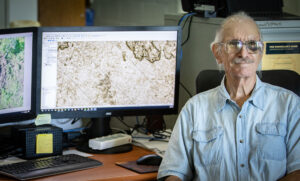Gregory Jackmond (Samoa) | archaeologist in Samoa

Gregory Jackmond (Samoa 1974-76)
Gregory Jackmond (Samoa 1974-76) carried out extensive archaeological field work in Samoa during the 1970s when he was a PCV in the islands. He surveyed pre-historic ruins from Sapapali’I and another large settlement in Palauli district where the Pulemelei Mound is situated.
The features visible include platforms (for houses), star mounds, terraces, walls, walled walkways, elevated walkways, large earthen ovens (umu ele’ele or umu ti), drainage channels, large pits, forts and just piles of stone.
Umu ele’ele, according to Jackmond, were large earth ovens which were used about 500 to 1000 years ago to make sugar from ti trees. “The ti root apparently was cooked for about 10 hours in a lot of heat. The result was sugar for the people at the time,” he said.
He found remnants of stone structures that dated back hundreds of years and upon his return to California in the U.S. at the end of his volunteer stint, he passed on his work to colleagues on the island.
He returned to Samoa in 2016 after his retirement as a teacher in California wanting to do something meaningful and exciting. He wanted to help develop the archaeology department at the Center of Samoan Studies.
The discovery of more sites and ancient artefacts were made possible through the use of what is called Lidar [light detection and ranging] maps over the last 6 years. “We have been able to build a database that can be used by anyone who is interested, not just university students,” he said.
The Lidar map data for Samoa shows that the islands are covered with archaeological features from the coast to the inland, as they can be seen where deep forest canopy has been cleared (8 kilometers or more inland in some areas).
“There’s so much that is not really known about Samoa that basically every time that we go out to do archaeological work we find something new.”
New findings include evidence of a greater population in Savai’i than previously thought, and their work suggests that Samoa’s population was twice what it is today.
Jackmond claimed Samoa has always been looked at by other archaeologists as a ‘strange place’, due to its different archaeological history from the rest of Polynesia.
“We kind of have to look at that and say, if this is the supposed birthplace of Polynesia, how can we have so much difference between us and every place else?”
In order to answer the question, this former Peace Corp volunteer said he is studying the ‘virgin soil disease’ in north and south America. This was when migrant settlers introduced new diseases that decimated the indigenous populations of Polynesian countries such as Hawaii and Tahiti. However, this did not happen in Samoa until the arrival of the missionaries in the 1830s.
 The findings of Jackmond’s work remains inconclusive to this day. Questions such as the fate of Samoa’s missing population remains unanswered.
The findings of Jackmond’s work remains inconclusive to this day. Questions such as the fate of Samoa’s missing population remains unanswered.
One takeaway, though, is he was able to use his information technology background to advance methods of conducting fieldwork from tape measures and compasses to the use of smartphones for surveys.
“When I did surveys in the late ’70s the idea was that what most archaeologists had found in American Samoa they did not expect for us to find here,” he said. “But the truth is it is everywhere in Samoa, everywhere you look there is something new to uncover.”
Expressing confidence in the growth of archaeology students and researchers in the country, Jackmond said there appears to be an awakening, in terms of interest in the specialized field.
“Before the curriculum in the schools never really talked about the prehistory of Samoa, but not one of the teachers has 40 students or so in each of his two classes. More and more students are majoring in archaeology and that is a good sign because if Polynesia started from here, then Samoa should be the center of archaeology for the region.”
It would seem as well to be where the heart of Jackmond’s work lies. In furthering Samoa’s reputation as an archaeological hub and unravelling the mysteries of Samoa’s ancient civilizations.
No comments yet.
Add your comment